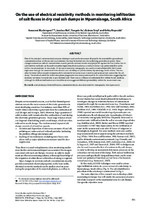| dc.contributor.author | Muchingami, Innocent | |
| dc.contributor.author | Nel, Jacobus | |
| dc.contributor.author | Xu, Yongxin | |
| dc.contributor.author | Steyl, Gideon | |
| dc.contributor.author | Reynolds, Kelley | |
| dc.date.accessioned | 2013-10-13T21:01:45Z | |
| dc.date.available | 2013-10-13T21:01:45Z | |
| dc.date.issued | 2013 | |
| dc.identifier.citation | Muchingami, I., et al. (2013). Application of the rainfall infiltration breakthrough (RIB) model for groundwater recharge estimation in west coastal South Africa. Water SA, 39(2): 491-498 | en_US |
| dc.identifier.issn | 0378-4738 | |
| dc.identifier.uri | http://hdl.handle.net/10566/754 | |
| dc.description.abstract | One of the principal environmental concerns relating to coal combustion waste disposal is the potential for groundwater
contamination from salt fluxes and trace elements that may be leached into the underlying groundwater system. Since
changes in moisture and salt concentrations usually provide contrasts in electrical properties against the host media, electri
-
cal resistivity methods can be used to monitor ingression of solute plumes as well as to detect any preferential flow paths
within the ash medium. In this study, 2D electrical resistivity tomography was used to monitor brine (10% NaCl) water
ingression through the unsaturated zone of a dry coal ash dump at a power station, Mpumalanga, South Africa. This was
after the initial laboratory determination of the relation between electrical resistivity and moisture/salt content for the ash
dump. The results showed that infiltration plume progression was more pronounced in the vertical direction, suggesting that
moisture movement is mainly due to gravitational pull. There was no evidence of preferential flow within the ash medium,
although the different infiltration rates for different sites suggested different permeability within the unsaturated zone. | en_US |
| dc.language.iso | en | en_US |
| dc.publisher | Water Research Commission | en_US |
| dc.rights | Copyright Water Research Commission. This file may be freely used for educational purposes, as long as it is not altered in any way. Acknowledgement of the authors and the source is required. | |
| dc.subject | Coal ash dumps | en_US |
| dc.subject | Brine infiltration | en_US |
| dc.subject | Cementation factor | en_US |
| dc.subject | Electrical resistivity tomography | en_US |
| dc.subject | Time lapse survey | en_US |
| dc.title | On the use of electrical resistivity methods in monitoring infiltration of salt fluxes in dry coal ash dumps in Mpumalanga, South Africa | en_US |
| dc.type | Article | en_US |
| dc.privacy.showsubmitter | false | |
| dc.status.ispeerreviewed | true | |
| dc.description.accreditation | Department of HE and Training approved list | en_US |

